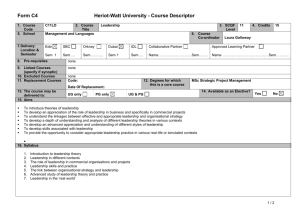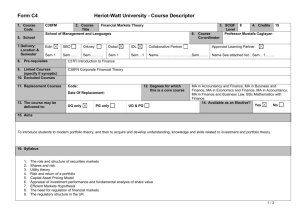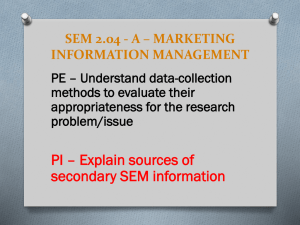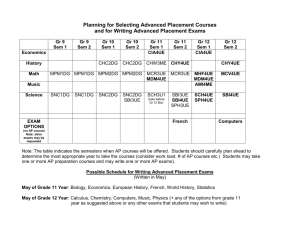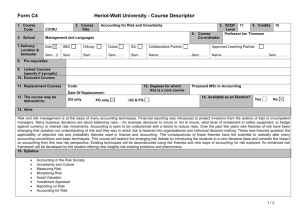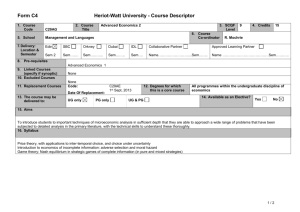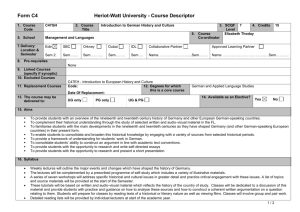Organizing Framework
advertisement
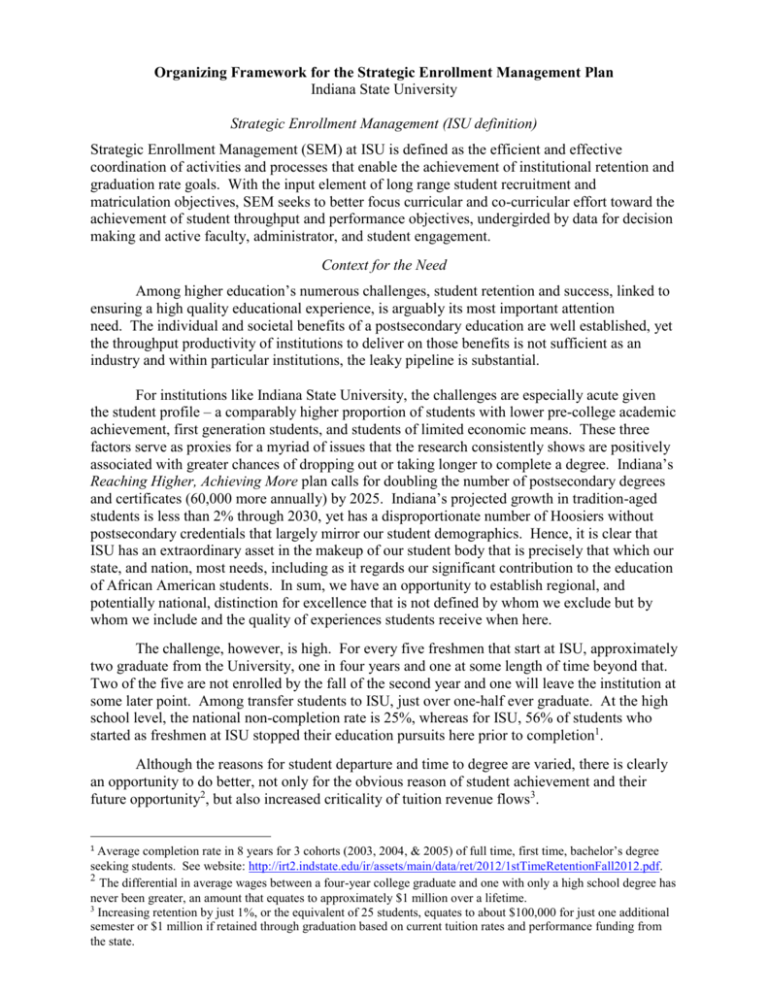
Organizing Framework for the Strategic Enrollment Management Plan Indiana State University Strategic Enrollment Management (ISU definition) Strategic Enrollment Management (SEM) at ISU is defined as the efficient and effective coordination of activities and processes that enable the achievement of institutional retention and graduation rate goals. With the input element of long range student recruitment and matriculation objectives, SEM seeks to better focus curricular and co-curricular effort toward the achievement of student throughput and performance objectives, undergirded by data for decision making and active faculty, administrator, and student engagement. Context for the Need Among higher education’s numerous challenges, student retention and success, linked to ensuring a high quality educational experience, is arguably its most important attention need. The individual and societal benefits of a postsecondary education are well established, yet the throughput productivity of institutions to deliver on those benefits is not sufficient as an industry and within particular institutions, the leaky pipeline is substantial. For institutions like Indiana State University, the challenges are especially acute given the student profile – a comparably higher proportion of students with lower pre-college academic achievement, first generation students, and students of limited economic means. These three factors serve as proxies for a myriad of issues that the research consistently shows are positively associated with greater chances of dropping out or taking longer to complete a degree. Indiana’s Reaching Higher, Achieving More plan calls for doubling the number of postsecondary degrees and certificates (60,000 more annually) by 2025. Indiana’s projected growth in tradition-aged students is less than 2% through 2030, yet has a disproportionate number of Hoosiers without postsecondary credentials that largely mirror our student demographics. Hence, it is clear that ISU has an extraordinary asset in the makeup of our student body that is precisely that which our state, and nation, most needs, including as it regards our significant contribution to the education of African American students. In sum, we have an opportunity to establish regional, and potentially national, distinction for excellence that is not defined by whom we exclude but by whom we include and the quality of experiences students receive when here. The challenge, however, is high. For every five freshmen that start at ISU, approximately two graduate from the University, one in four years and one at some length of time beyond that. Two of the five are not enrolled by the fall of the second year and one will leave the institution at some later point. Among transfer students to ISU, just over one-half ever graduate. At the high school level, the national non-completion rate is 25%, whereas for ISU, 56% of students who started as freshmen at ISU stopped their education pursuits here prior to completion1. Although the reasons for student departure and time to degree are varied, there is clearly an opportunity to do better, not only for the obvious reason of student achievement and their future opportunity2, but also increased criticality of tuition revenue flows3. Average completion rate in 8 years for 3 cohorts (2003, 2004, & 2005) of full time, first time, bachelor’s degree seeking students. See website: http://irt2.indstate.edu/ir/assets/main/data/ret/2012/1stTimeRetentionFall2012.pdf. 2 The differential in average wages between a four-year college graduate and one with only a high school degree has never been greater, an amount that equates to approximately $1 million over a lifetime. 3 Increasing retention by just 1%, or the equivalent of 25 students, equates to about $100,000 for just one additional semester or $1 million if retained through graduation based on current tuition rates and performance funding from the state. 1 SEM Organizational Framework Substantial groundwork progress has already been achieved via the efforts of a number of groups including the Student Success Council, Strategic Plan Goal 1 initiative teams, an ad hoc initial SEM team formed this spring, and an ad hoc SEM Short Term Tactical Team that spearheaded the early registration effort among other activities. Furthermore, a considerable amount of work has been in the data collection and analysis arena. Through the development of a formalized SEM plan, now is the opportunity to solidify new processes and orientations to the issue of student retention and success while also expanding them to involve others more intentionally and to capitalize on last spring’s momentum. To that end, a SEM Steering Team has been formed to provide overall guidance and high level abilities to enable both strategic and tactical activities to occur, particularly those that require working across traditional lines and impact traditional operational activities. The six members include Cabinet, Dean, and faculty representation. The members are Josh Powers, Interim Associate Vice President for Student Success, John Beacon, Vice President for Enrollment Management, Linda Maule, Dean of University College, Carmen Tillery, Vice President for Student Affairs, Linda Ferguson, Chair of the SEM Data Team, and Michael Chambers, Professor and Chair of the Department of Political Science. The Student Success Council, an 18 member committee formed a few years ago and codified in University policy (http://www.indstate.edu/adminaff/docs/270%20University%20Committees.pdf#270.1 ), plays an important role in the SEM process. Josh Powers and Linda Maule co-chair the Council that have the task of assisting in the review of current retention and success efforts, their effective coordination, and the development of specific strategic goals and assessment plans to be deployed through its subcommittee structure. A set of 3-4 tactically oriented subcommittees will report to the Student Success Council, populated by interested members of the Student Success Council as well as others invited to participate as it may aid goal achievement such as chairs or members of Goal 1 Initiatives. Also participating in the SEM effort and functioning as partnered committees to the Council are the SEM Short Term Tactical Team and the CRM Tactical Team. The former is laser focused on immediate term opportunities through cross-unit cooperation and collaboration in areas such as facilitating early registration and improved communication with students. The latter is developing a pilot system that will enhance what is now possible for early alerts on potential at risk students with the goal of an appropriate intervention to support their success. A Data Team supports the SEM initiative. Its members include Catherine Tucker and Will Barratt (faculty data consultants), Charlene Shivers (Financial Aid); Christopher Childs (Student Success); Deirdre Mahan (Admissions); Jerome Cline (IR); Tess Avelis (Registrar); Julie Cuffle (IT), and Linda Ferguson (IR and Chair of the Data Team). John Beacon, Vice President for Enrollment Management, leads a parallel Recruitment Council or what is called the Forecasting Group, that in the context of SEM, has the responsibility of considering new student recruitment and matriculation goals and action plans. The next page visually maps the organizing framework. Specific meeting dates are also indicated. ISU SEM Organizational Framework SEM Steering Team Purpose: High level guidance Enabler of cross-unit planning and action Reviews and approves recommendations of the Councils Recruitment Council Student Success Council (current Forecasting Group) Purpose: Purpose: Development of strategic goals and assessment framework Visions opportunities for action and improved focus of activities and energy Supports work of subcommittees Development of strategic goals and assessment framework Visions opportunities for action and improved focus of activities and energy Tactical Subcommittees Tactical Subcommittees Purpose: Action planning & execution Timelines and metrics Activity assessment Purpose: Action planning & execution Timelines and metrics Activity assessment Data Team Purpose: Environmental scanning Student enrollment behavior research Retention and success modeling Providing data to inform planning and action Operational Schedule 4 August 22 & 23; SEM Kickoff (collective session 8-12noon4; HMSU 407; subgroup breakouts in PM and on 23rd) September 18 & 19; Recruitment & Retention Goal Review5; HMSU 918 October 2; Strategy and Tactic Development; 8-10a; SCOB 222 October 17; Strategy and Tactic Development Check with Tom Green of AACRAO; 8:30am – 12noon & Lunch with Forecasting Group 12-1pm; HMSU 407 October 30; Strategy and Tactics Refinement; 8-10am; SCOB 222 November 12; Strategy and Tactics Refinement Check with Tom Green of AACRAO; 8:30-12noon & Lunch with Forecasting Group 12-1pm; HMSU 918 November 27; Finalize SEM Plan; 8-10am; SCOB 222 December 11; Plan Development Wrap-Up with Tom Green, AACRAO; 11-1pm with working lunch & 3-4:30pm presentation to SEM Steering Team with celebration reception to follow; HMSU 407 January 8; SEM Launch with Tom Green of AACRAO; Time TBA; HMSU 407 February 5 & 6; Strategy Implementation Progress Check with Tom Green of AACRAO; Time TBA; HMSU 407 March 20-21; Implementation Reporting Event with Tom Green of AACRAO; Time TBA; HMSU 407 Others on campus invited to attend this opening session, including Strategic Plan Goal 1 initiative chairs. Open sessions held for the campus community. 5


